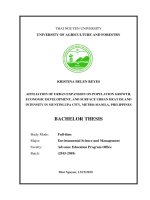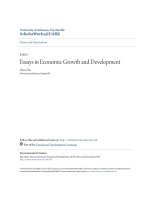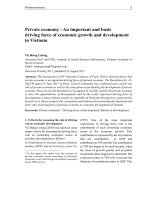Economic growth and economic development 714
Bạn đang xem bản rút gọn của tài liệu. Xem và tải ngay bản đầy đủ của tài liệu tại đây (110.54 KB, 1 trang )
Introduction to Modern Economic Growth
(6) Characterize the Pareto optimal allocation in this economy and show that
the Pareto optimal ratio of technologies in the stationary equilibrium are
also given by (15.27).
Exercise 15.19. Consider version of the baseline directed technological change
model introduced above with the only difference that technological change is driven
by quality improvements rather than expanding machine varieties. In particular, let
us suppose that the intermediate goods are produced with the production functions:
∙Z 1
¸
1
1−β
qL (ν, t)xL (ν, t | q) dν Lβ , and
YL (t) =
1−β 0
¸
∙Z 1
1
1−β
YH (t) =
qH (ν, t)xH (ν, t | q) dν H β .
1−β 0
Producing a machine of quality q costs ψq, where we again normalize ψ ≡ 1 − β.
R&D of amount Zf (ν, t) directed at a particular machine of quality qf (ν, t) leads to
machine
an innovation at the flow rate η f Zf (ν, t)/qf (ν, t) and
´
³ leads to an improved
of quality λqf (ν, t), where f = L or H, and λ ∈ 1, (1 − β)−(1−β)/β , so that firms
that undertake an innovation can charge the unconstrained monopoly price.
(1) Define an equilibrium in this economy.
(2) Specify the free entry conditions for each machine variety.
(3) Characterize the BGP equilibrium, show that it is uniquely defined and
determine conditions such that the growth rate is positive and the tougher
sell at the condition is satisfied.
(4) Show that the relative technologies in the BGP equilibrium are given by
(15.27).
(5) Show that the equivalents of Propositions 15.3 and 15.4 hold in this environment.
(6) Characterize the transitional dynamics and show that they are similar to
those in Proposition 15.2.
(7) Characterize the Pareto optimal allocation in this economy and show that
the Pareto optimal ratio of technologies in the stationary equilibrium are
also given by (15.27).
(8) What are the pros and cons of this model relative to the baseline model
studied in Section 15.3.
700









